While most plants rely on sunlight for photosynthesis, there exists a select group that has evolved unique strategies to obtain their energy. In this article, we’ll delve into their secrets and discover how they manage to flourish in the shadows, from dense forests to dimly lit corners of your home.
Before we start, it’s worth mentioning that no plant can live 100% without sunlight. The plants on this list need very little of it, but they make great use of that little bit of sun.
1. Dracaena
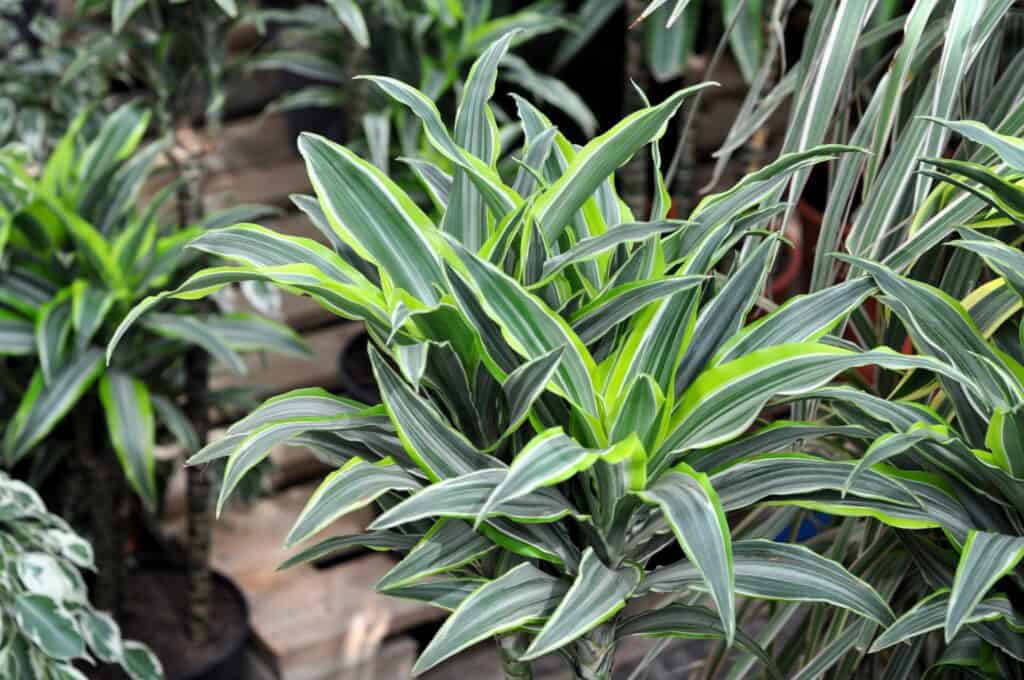
These plants are quite popular in the houseplant trade.
©Oksana Lyskova/Shutterstock.com
Dracaena, a popular houseplant, is known for its vibrant foliage and low maintenance requirements. It is native to tropical regions of Africa and Asia. This ornamental plant has adapted well to indoor environments, making it a favorite among indoor gardeners. Its ability to thrive in low light conditions is a notable feature. This makes it an excellent choice for spaces with limited sunlight.
In terms of appearance, the dracaena boasts slender, upright stems that bear long, sword-shaped leaves. The leaves exhibit various color combinations, ranging from rich green to deep burgundy, often featuring striking stripes or patterns. This diversity in leaf color and design makes dracaena a versatile addition to home decor. It can add a touch of nature’s beauty to any room.
One important aspect to consider when growing dracaena is its toxicity. While it is generally safe for humans, caution should be exercised around pets, as dracaena is known to be toxic to cats and dogs. Ingesting the plant can lead to symptoms like vomiting, drooling, and gastrointestinal discomfort in pets. Therefore, it’s crucial to keep dracaena out of reach of your furry friends or opt for pet-friendly indoor plants if you have pets at home.
2. Weeping Fig Tree
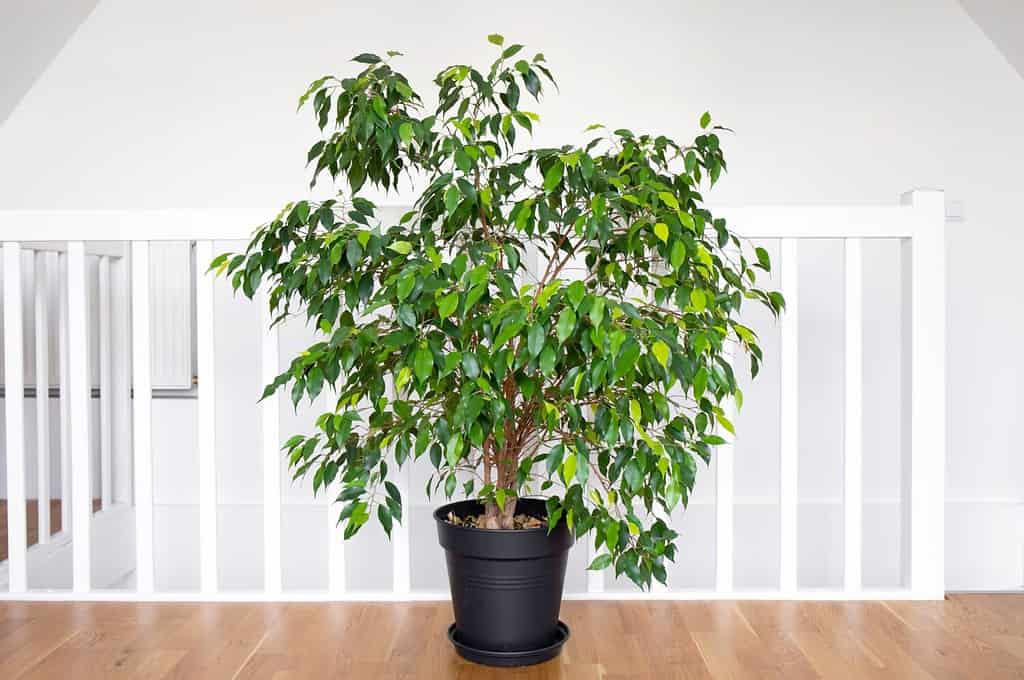
©FotoHelin/Shutterstock.com
The Weeping Fig Tree is a popular and graceful indoor plant cherished for its elegant appearance and ease of care. It is native to Southeast Asia and Northern Australia. This charming tree has found its way into homes and offices worldwide, thriving as a captivating addition to interior landscapes.
What sets the Weeping Fig Tree apart is its adaptability to lower light conditions. Unlike some demanding sun-worshipping plants, the Weeping Fig is content with moderate to indirect sunlight. This makes it an ideal choice for areas with limited natural light. Such areas include living rooms, bedrooms, or offices with filtered sunlight. Its ability to flourish in such conditions is a testament to its resilience and versatility.
In terms of aesthetics, the Weeping Fig Tree is a sight to behold. It features slender, glossy green leaves that cascade gracefully, giving it a “weeping” or drooping appearance. These lush, evergreen leaves create an air of tranquility and bring a touch of the outdoors inside. As the tree matures, it can grow to various heights. It can range from a few feet to several feet tall. This makes it suitable for both compact spaces and more spacious environments.
Despite being a wonderful interior companion, the Weeping Fig Tree may be harmful to animals, so it’s important to be mindful of this. The plant produces latex in its sap, which can irritate both people and animals. It may cause minor gastrointestinal distress, skin rashes, or allergic responses if consumed. If you have cats or dogs at home, it’s advisable for pet owners to either choose pet-friendly plants or to situate the weeping fig tree in a spot that is out of the way of curious animals.
3. ZZ Plant
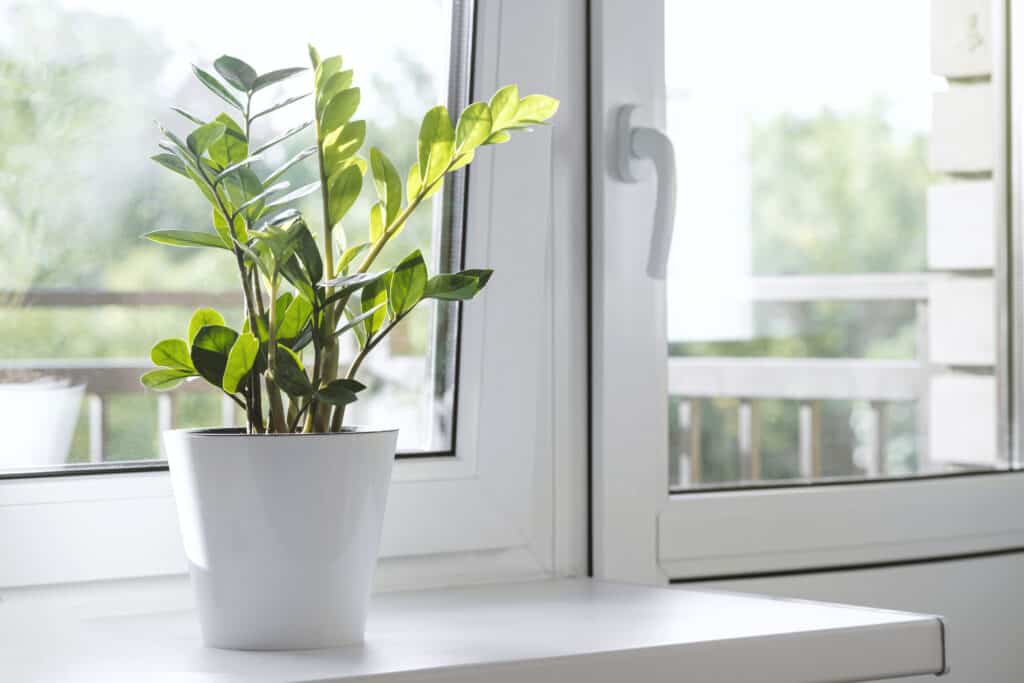
ZZ plants don’t need much sunlight and also don’t need much water.
©iStock.com/Kseniia Soloveva
The ZZ plant is a resilient and attractive houseplant that has gained popularity for its ability to thrive in low-light conditions. Native to eastern Africa, specifically Zanzibar, Tanzania, and Kenya, this hardy plant has become a favorite choice for both novice and experienced indoor gardeners.
One of the standout features of the ZZ plant is its remarkable tolerance for low light. This makes it an excellent option for spaces with minimal access to natural sunlight. It can happily flourish in offices with fluorescent lighting or rooms with indirect sunlight. Its adaptability to various light levels is a testament to its ability to thrive in challenging indoor environments.
In terms of appearance, the ZZ plant is characterized by its striking, glossy, dark green leaves. The leaves are comprised of multiple leaflets, giving them an attractive feather-like appearance. The plant’s natural symmetry and upright growth make it an aesthetically pleasing addition to any room or office setting. It typically reaches a height of about two to three feet when grown indoors.
One notable advantage of the ZZ plant is its non-toxic nature. Unlike some indoor plants that can pose risks to pets or small children, the ZZ plant is considered safe. Ingesting its leaves or stems is unlikely to result in harmful effects for humans or animals. This makes it an ideal choice for households with pets or young kids, as it adds a touch of greenery without compromising safety.
4. Parlor Palm
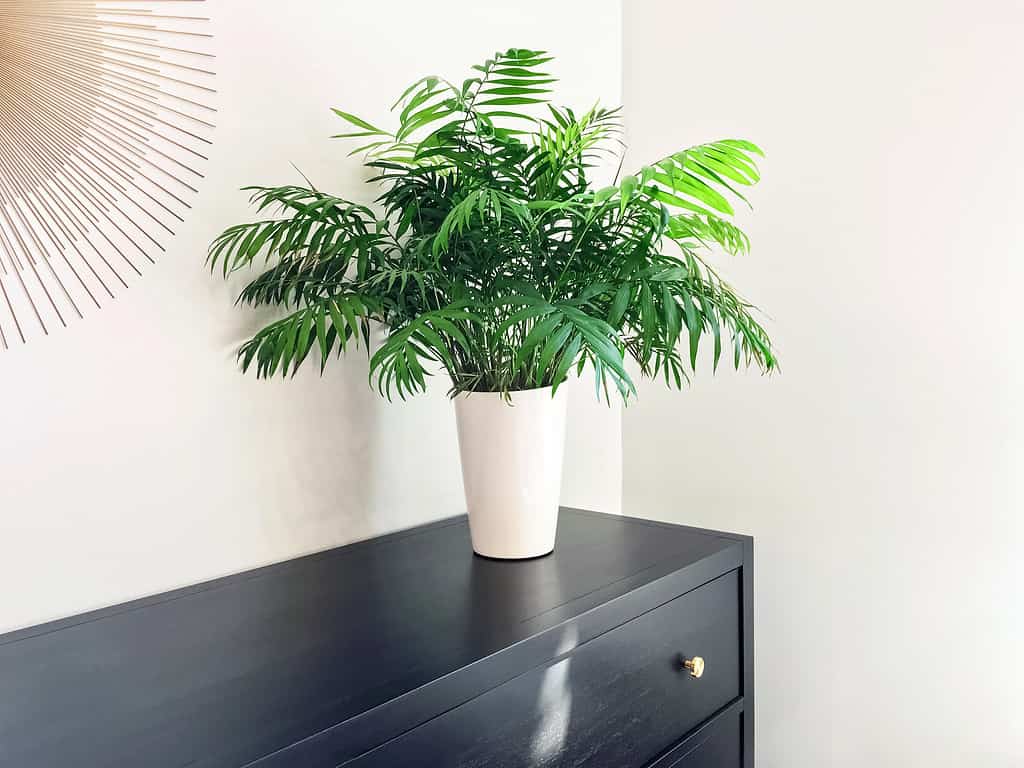
Parlor palms are a great pick for households with pets and children.
©Studio Light and Shade/Shutterstock.com
The Parlor Palm is a beloved indoor plant celebrated for its elegant appearance and adaptability to low-light conditions. This tropical gem hails from the rainforests of Southern Mexico and Guatemala, where it thrives beneath the dense canopies, making it well-suited for indoor environments.
The Parlor Palm’s capacity to thrive with little sunshine is one of its most alluring features. It doesn’t need a ton of sun, but it does like indirect light. This plant is therefore a great option for locations with little natural light, including workplaces or rooms with north-facing windows. The Parlor Palm is a well-liked option for indoor gardeners looking for a low-maintenance plant due to its ability to grow in low-light settings.
In terms of appearance, the Parlor Palm presents itself with grace. Its slender stems are adorned with arching, feather-like fronds, which give it a lush and tropical appearance. The leaves are deep green and often have a delicate, airy texture. When mature, this palm can reach heights of up to four feet, making it a perfect addition to homes or offices, adding a touch of nature’s elegance.
As for its safety, the Parlor Palm is considered non-toxic to both humans and pets. This means that if accidentally ingested by curious pets or small children, it is unlikely to cause harm. It’s still advisable to keep any plant out of the reach of pets and young ones to prevent unintended interactions, but the Parlor Palm’s non-toxic nature provides an extra layer of reassurance for households with furry friends or little explorers.
5. Monstera
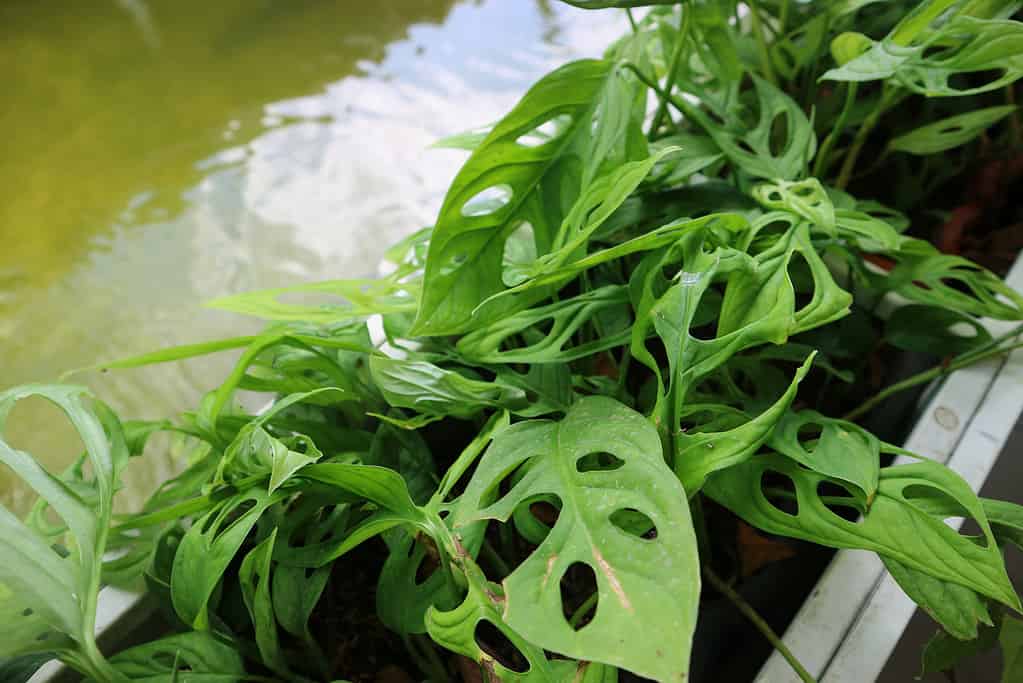
Monsteras are incredibly popular tropical plants in the houseplant market, mostly due to their unique “Swiss cheese” holes in their leaves.
©Irfani Kurniawati/ via Getty Images
The Monstera plant is a striking and popular indoor plant that has captured the hearts of plant enthusiasts around the world. This captivating plant is native to the lush rainforests of Central America, including regions in Mexico and Panama, where it thrives beneath the dense jungle canopies.
One of the Monstera’s most appealing characteristics is its ability to thrive in low-light conditions. While it does appreciate some indirect sunlight, it doesn’t require excessive sun exposure. This adaptability makes it an ideal choice for indoor settings where natural light might be limited. It can thrive in various spaces, from homes with shaded corners to well-lit offices with filtered sunlight, making it a versatile addition to interior decor.
The Monstera is renowned for its distinctive appearance. Its large, glossy leaves are its standout feature, often displaying intricate natural perforations and splits. These unique fenestrations give the plant its distinctive look, earning it the nickname “Swiss Cheese Plant.” The leaves are deep green and can grow to impressive sizes, creating a bold and tropical aesthetic that instantly elevates any room it graces. The Monstera can climb or trail, depending on how it’s cared for, adding an element of flexibility to its display.
In terms of safety, the Monstera is generally considered non-toxic to humans. However, it’s essential to be cautious with pets. While the plant itself is not highly toxic, ingesting its leaves can lead to mild digestive discomfort in animals. To ensure the safety of both pets and children, it’s advisable to place the Monstera in a location where it’s out of their reach.
6. Cast Iron Plant

Cast Iron Plants are not poisonous, making them a great choice for households with pets and/or little ones.
©mizy/Shutterstock.com
The Cast Iron Plant is a robust and enduring indoor plant admired for its remarkable resilience and adaptability to low-light conditions. This hardy plant is native to the lush woodlands of Japan and Taiwan, where it thrives on shaded forest floors, making it well-suited for indoor environments.
One of the most noteworthy attributes of the Cast Iron Plant is its ability to flourish without the need for copious sunlight. It is perfectly content with low light or indirect sunlight, making it an excellent choice for rooms with minimal natural light. Whether it’s placed in a dimly lit corner of your home or an office with filtered sunlight, this plant can thrive and enhance the atmosphere without demanding much in return.
In terms of appearance, the Cast Iron Plant boasts handsome dark green leaves that are lance-shaped and glossy. These leaves rise gracefully from the plant’s base, creating a lush and dense foliage that can add a touch of elegance to any interior setting. While it doesn’t produce showy flowers, the robust foliage alone makes it an attractive addition to homes and offices.
When it comes to safety, the Cast Iron Plant is generally considered non-toxic to both humans and pets. Its leaves do not contain harmful compounds that pose a significant threat. However, while it’s not poisonous, it’s essential to maintain caution if you have curious pets or small children. Ingesting any plant material, even non-toxic ones, can still lead to digestive discomfort in pets or minor irritation in humans. To prevent unintended interactions, it’s wise to place the Cast Iron Plant in a location where it is not accessible to pets or young ones.
7. Chinese Evergreen
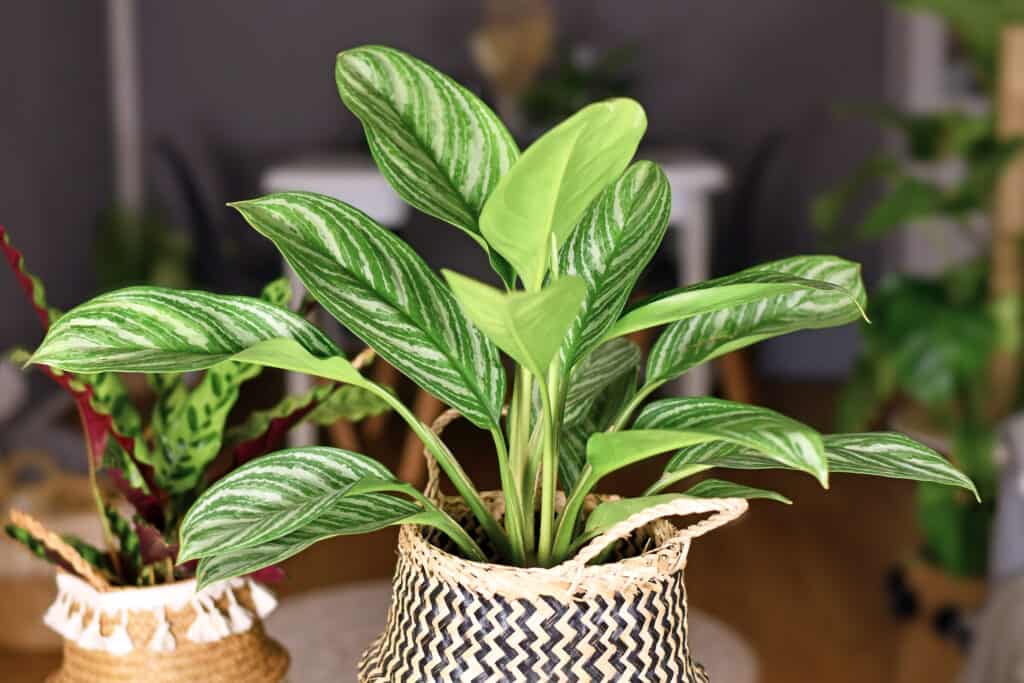
Chinese Evergreen plants have a unique appearance, complete with broad, striped leaves that have an elegant look.
©iStock.com/firn
The Chinese Evergreen plant is a well-liked houseplant valued for its eye-catching leaves and capacity to withstand low lighting. This tropical treasure is endemic to Southeast Asia’s lush rainforests. It is notably found in Malaysia, Indonesia, and the Philippines, where it thrives under the thick tree canopy.
The Chinese Evergreen’s capacity to thrive with no sunlight is one of its most alluring features. It is a wonderful choice for interior places where access to natural sunlight may be restricted because it can grow in low to moderate light. This plant’s versatility guarantees that it may survive without much hassle whether it is kept in a room with filtered sunlight or an office with fluorescent illumination.
In terms of appearance, the Chinese Evergreen showcases an array of striking foliage. Its leaves come in various shades of green. It is often adorned with unique patterns of stripes, spots, or splashes of silver or cream. This detail adds a touch of elegance to its overall aesthetic. The leaves have an oval or lance-shaped structure and grow in an upright manner, creating a lush, dense appearance. As the plant matures, it can reach heights of up to three feet.
Safety-wise, the Chinese Evergreen is considered a low-toxicity plant. While it’s generally safe for humans, ingestion of its leaves or stems can cause mild irritation or discomfort. In pets, similar mild symptoms may occur if the plant is ingested. To ensure the safety of both humans and animals, it’s advisable to place the Chinese Evergreen in a location that is out of reach of pets and children.
8. Dragon Tree

Dragon Trees are known for their very strange look, as well as their ability to live as a houseplant with relative ease.
©Wirestock Creators/Shutterstock.com
The Dragon Tree is a popular indoor plant renowned for its striking appearance and low-light adaptability. Native to Madagascar, this elegant plant has found its way into homes and offices around the world, captivating indoor gardeners with its unique charm.
The Dragon Tree’s capacity to survive with no sunlight is one of its most prominent characteristics. It is a great choice for indoor places where sunshine may be scarce. This plant can thrive in low to moderate light levels. The Dragon Tree’s versatility guarantees that it can survive with little sun exposure, whether it is put in a poorly lit room or an office with filtered sunlight.
The Dragon Tree is characterized by its long, lance-shaped leaves and thin, woody stems. The leaves, which are normally dark green with startling reddish or purple margins, give the plant’s appearance a dramatic touch. It adds visual interest to home décor thanks to the architectural character of its development and the vivid colors. The Dragon Tree may grow from a few feet to many feet tall, depending on its surroundings and maintenance.
The Dragon Tree is typically regarded as non-toxic to people and animals in terms of safety. This indicates that it is unlikely to damage you seriously if you accidentally consume it. Pets and young children should, however, be handled carefully. This is because even non-toxic plant material might cause moderate stomach pain if consumed. It is advisable to put the Dragon Tree out of reach of animals and small children to provide a secure atmosphere.
Summary of Houseplants that Don’t Need Any Sunlight to Thrive
| # | Plant | Water Needs |
|---|---|---|
| 1 | Dracaena | Moderate |
| 2 | Weeping Fig Tree | High |
| 3 | ZZ Plant | Low |
| 4 | Parlor Palm | Moderate |
| 5 | Monstera | Moderate |
| 6 | Cast Iron Plant | Low |
| 7 | Chinese Evergreen | Moderate |
| 8 | Dragon Tree | Moderate |
Thank you for reading! Have some feedback for us? Contact the AZ Animals editorial team.








